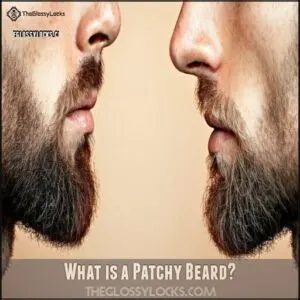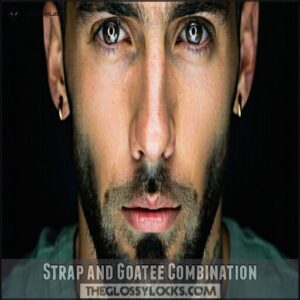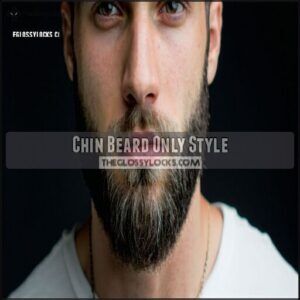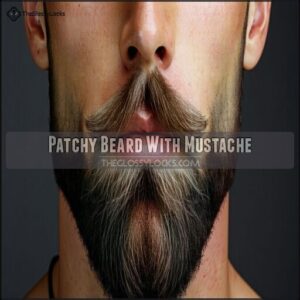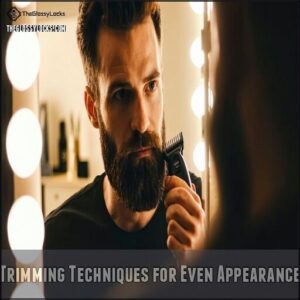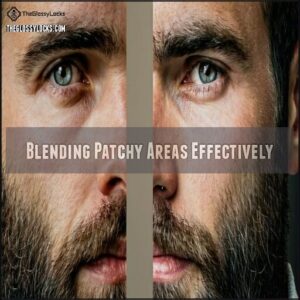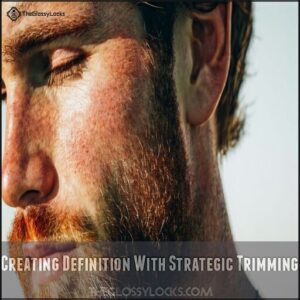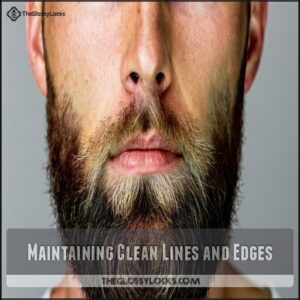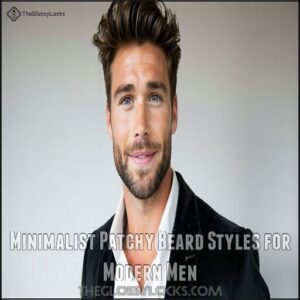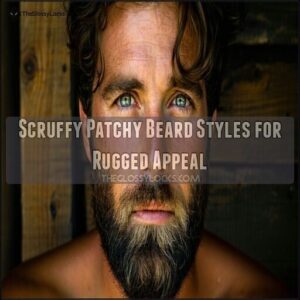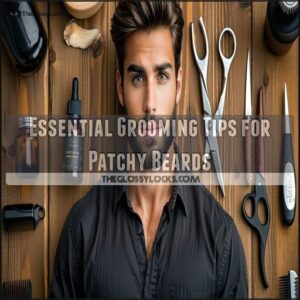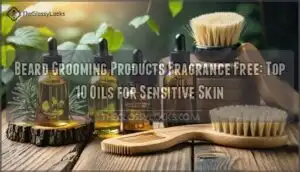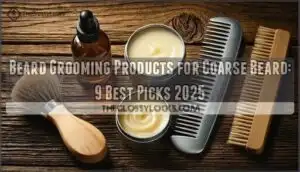This site is supported by our readers. We may earn a commission, at no cost to you, if you purchase through links.
 Patchy beard styles prove that less is more in personalizing your look.
Patchy beard styles prove that less is more in personalizing your look.
Whether you rock a sharp chin beard, a sleek goatee, or the rugged “just rolled out of the woods” vibe, a patchy beard adds character and charm.
Embrace the natural gaps—think of them as blank spaces on your canvas, and play up your strengths, like highlighting a strong jaw with a thin strap or balancing your face with a faded cheek style.
The key? Confidence, as a patchy beard isn’t a flaw—it’s a signature that allows you to own yours.
Let’s break down the best styles to get inspired.
Table Of Contents
- Key Takeaways
- What is a Patchy Beard?
- Embracing Your Unique Patchy Beard Style
- Popular Patchy Beard Styles to Try
- Artfully Clipping and Shaping Patchy Beards
- Highlighting Facial Features With Patchy Beards
- Minimalist Patchy Beard Styles for Modern Men
- Scruffy Patchy Beard Styles for Rugged Appeal
- Improving Patchy Beard Growth Naturally
- Essential Grooming Tips for Patchy Beards
- Confidence-Boosting Strategies for Patchy Beard Wearers
- Frequently Asked Questions (FAQs)
- What are patchy beard styles?
- How do you style a patchy beard?
- Can you have a patchy beard?
- How to shave a patchy beard?
- Can a patchy beard be combined with a haircut?
- What styles make a patchy beard a point of pride?
- What is the best style for a patchy beard?
- Is a patchy beard attractive?
- Do all patchy beards fill in?
- Can a patchy beard look good?
- Conclusion
Key Takeaways
- Embrace your patchy beard by working with its natural growth patterns instead of hiding them, and choose styles like the Van Dyke, goatee, or scruffy look to highlight your unique features.
- Confidence is key—trim intentionally, groom regularly with beard oil or balm, and own your style regardless of patches.
- Focus on proper skin and beard care with cleansing, exfoliating, and hydrating routines to improve growth and maintain a healthy appearance.
- Experiment with styles and lengths, like pairing a full goatee with faded cheeks or a thin strap for defined jawlines, to find what best complements your face shape.
What is a Patchy Beard?
You’ve got a patchy beard if your facial hair grows unevenly, with some areas thicker than others and noticeable gaps where hair growth is sparse or completely absent.
Don’t worry, it’s incredibly common and often due to genetics or hormone levels, but with the right styling techniques, you can transform those patches into a distinctive look that works for you.
Defining Characteristics of Patchy Beards
A patchy beard isn’t just facial hair—it’s a unique pattern that defines your look.
- Uneven hair distribution across cheeks, jaw, and chin creates distinctive asymmetry
- Varying density with some areas showing robust growth while others remain sparse
- Inconsistent texture where some hairs might be coarse while others are fine
- Asymmetrical growth patterns between the left and right sides of your face
- Visible skin showing through certain areas, creating natural contrast
Your beard’s patchiness isn’t a flaw—it’s your signature facial architecture.
Common Causes of Patchy Beard Growth
Now that you understand what patchy beards look like, let’s talk about why they happen.
Your beard’s spotty appearance often stems from genetic factors—thanks, Dad!
Hormone imbalances, particularly low testosterone levels, can leave you with thin spots.
Stress effects show up quickly, turning your facial hair uneven.
Poor nutrition (especially lacking B vitamins) and health issues impact growth too.
Age plays a role, as younger men typically have more patchy growth.
Even hair follicle damage from aggressive shaving contributes!
Genetic Factors Influencing Beard Patchiness
Your beard’s patchiness isn’t random—it’s written in your DNA.
Patchy beards tell your unique story—every gap and strand is a part of your DNA blueprint.
While some men inherit dense follicle patterns, others get a more scattered distribution of androgen receptors.
The AR gene and testosterone-related genes dictate your beard density and growth rate.
Looking at male relatives often reveals your inheritance patterns.
Don’t worry though—genetics dealt you this hand, but you’ll soon learn how to play it masterfully!
Hormonal Imbalances and Patchy Beards
Beyond your genetics, hormonal factors can substantially impact your beard’s growth pattern. When testosterone levels dip below normal, beard follicles may struggle to mature properly, creating those frustrating patchy areas.
- Feeling frustrated when beard supplements don’t deliver their promised results
- Experiencing the disappointment of seeing patchy growth despite your best efforts
- Wondering why your friends grow full beards effortlessly while you struggle
- Facing social pressure to have that perfectly masculine facial hair
- Yearning for the confidence that comes with a beard that matches your vision
Androgen sensitivity, thyroid issues, and stress can all contribute to hormonal imbalance. Don’t worry—understanding your growth patterns is the first step toward improvement.
Embracing Your Unique Patchy Beard Style
The journey to a jaw-dropping beard begins with embracing what makes yours unique.
Your patchy facial hair isn’t a flaw—it’s your signature style waiting to happen.
Those irregular growth patterns can become your greatest asset with the right approach to beard care.
Start by mapping your natural growth patterns and experimenting with different lengths.
Many stylish patchy beards look intentional when properly maintained.
Remember, beard confidence comes from owning your look, not hiding it.
"My patchy cheeks became my trademark," says Jake, a beard enthusiast.
"Once I stopped fighting it and found the right styling tips, compliments started rolling in."
Try patchy beard solutions like strategic trimming to enhance your strongest areas.
Facial hair doesn’t need perfect uniformity to look amazing.
The best patchy beard styles work with—not against—your natural growth, creating distinctive looks that perfectly frame your features, and this can lead to a truly jaw-dropping beard with the right care and styling tips.
Popular Patchy Beard Styles to Try
You’ll find a patchy beard style that perfectly showcases your unique growth pattern, transforming what you might see as a flaw into your signature look.
From the rugged Wild Approach to the sophisticated Van Dyke, these styles don’t hide patches—they make them work for you, embracing the unique aspects of your beard.
The Thin Strap Look
Now that you’ve decided to rock your patchy beard, let’s check out the Thin Strap Look.
This jawline style transforms sparse growth into a deliberate fashion statement.
- Defines your jawline perfectly, creating sharp facial contours
- Requires minimal maintenance with basic trimming skills
- Works with or without a mustache for versatile styling options
Perfect for patchy cheeks, this thin beard style turns facial hair limitations into your signature look!
Strap and Goatee Combination
The strap and goatee combination delivers a knockout punch for guys with patchy cheeks but strong jawline growth.
This classic facial hair style pairs a defined chin strap with a complementary goatee, creating dimension and structure.
Regular beard trimming keeps both elements sharp, while beard oil maintains softness.
By connecting these two design elements, you’ll transform patchy beard areas into a deliberate style statement that accentuates your chin’s natural angles, making a strong style statement.
Chin Beard Only Style
The chin beard style is perfect for men with patchy cheeks but strong growth below the lip.
Unlike the strap-and-goatee combo, this focused approach draws attention to your jawline.
When styling your chin beard:
- Keep it well-trimmed for a deliberate, not neglected look
- Shape it to complement your face structure
- Apply beard oil daily for healthy shine
- Gradually increase length to find your ideal statement
Patchy Beard With Mustache
Moving from chin-only styles, let’s explore the classic combo of patchy beard with mustache. This versatile style works wonders for uneven growth patterns.
Your mustache becomes the focal point while patchy areas add character. Try pairing a well-shaped disconnected pencil mustache with a scruffy patchy beard below. Add a soul patch for extra flair.
The key to mustache-goatee balance? Keep your goatee styles aligned with your face shape while maximizing fullness through proper shaping techniques.
The Wild and Rugged Approach
The wild and rugged approach embraces your beard’s natural patchiness as a feature, not a flaw.
Own your beard’s untamed charm—natural patchiness is a bold feature that sets you apart with rugged confidence.
This untamed growth style lets you channel your inner mountain man while working with what nature gave you.
The scraggly beard look celebrates imperfection with confident wildness.
- Let your facial hair grow freely for 4-6 weeks, allowing natural texture to develop
- Apply beard oil daily to soften coarse hairs and nourish the skin beneath
- Trim only minimally, focusing on neck and cheek lines for a deliberate rustic beard appearance
Understanding hormone imbalance effects can also help you address underlying issues that may impact your beard growth.
This laidback look requires minimal maintenance—perfect for the man who’d rather explore than primp!
Artfully Clipping and Shaping Patchy Beards
You’ll transform your patchy beard from a grooming challenge into your signature style with the right clipping and shaping techniques.
Much like a skilled sculptor who sees potential in rough stone, you can highlight your best facial features by strategically trimming back certain areas while letting others grow to create a deliberate, head-turning look that showcases your best facial features.
Trimming Techniques for Even Appearance
Your patchy beard deserves thoughtful trimming for that even, intentional look. Start with a longer guard setting on your beard trimmer, gradually working down to find your ideal length.
Trim patchy beard areas with precision, focusing on facial symmetry to create balance. Control edges with careful, deliberate strokes.
Different hair texture responds uniquely to trimming tools, so take your time—small, consistent adjustments create professional-looking results. To achieve the best trim, consider using a high-quality beard trimmer tool that suits your needs, ensuring a high-quality trim with precise control.
Blending Patchy Areas Effectively
The art of seamless beard blending transforms patchy areas into a cohesive style.
Master these four trimmer techniques:
- Taper gradually from thicker regions to sparse patches using decreasing guard sizes
- Create subtle density shifts by removing hair in small increments
- Brush in different directions while trimming to reveal uneven spots
- Focus on blending jawline patches with cheek growth for a defined look
The key to achieving a natural look is to master these techniques and practice them regularly to ensure a smooth, even blend.
Creating Definition With Strategic Trimming
Strategic trimming transforms your patchy beard from undefined to sculpted masterpiece.
With careful beard contouring, you’ll create definition that accentuates your natural features.
Vary your trimmer guard lengths to shape patchy beard areas into intentional style statements.
Focus your edge control on emphasizing jawlines and cheekbones—these styling tricks create structure where growth is sparse.
Remember, your beard trimming technique isn’t hiding patches; it’s highlighting your facial hair’s unique character.
Maintaining Clean Lines and Edges
Your beard’s clean lines transform an unkempt patch into a deliberate style statement.
Maintaining well-defined edges elevates even the patchiest beard:
- Define your neckline by creating a gentle curve from ear to ear, about two fingers above your Adam’s apple
- Shape your cheek line to complement your face shape, following your natural growth pattern
- Tame flyaways with a touch of beard balm for all-day edge definition
Highlighting Facial Features With Patchy Beards
You can turn your patchy beard into your best facial feature by strategically placing growth patterns to accentuate your natural bone structure.
Your uneven beard growth isn’t a flaw but a styling opportunity that, when trimmed with intention, can highlight your jawline and cheekbones better than a full beard ever could, making it a chance to accentuate your natural bone structure.
Emphasizing The Jawline
Now that you’ve mastered the clipping basics, let’s focus on your jawline. A well-defined jawline can transform your patchy beard into a statement piece.
Trimming along your natural jawline creates sharp beard contour that draws the eye. Keep sideburns shorter while allowing more growth along the chin accent area.
Careful neckline shaping prevents the dreaded "floating beard" look that plagues many patchy beard styles, ensuring a clean and defined jawline.
Accentuating Cheekbones
How can patches become your secret weapon for killer cheekbones? Selective growth in your cheek hollows creates natural contours that highlight your facial structure.
This patchy beard symmetry transforms "flaws" into features!
Try these cheekbone-enhancing techniques:
- Keep patches in cheek hollows to create depth and dimension
- Trim around your mouth while letting sideburns grow longer
- Follow Beckham’s style with longer scruff on cheeks for upward visual focus
Understanding the benefits of beard oil products can also enhance your patchy beard style.
Creating a Balanced Facial Appearance
Your beard can work wonders for facial symmetry, even if it’s patchy.
Use beard contour to balance your features—trimming uneven growth while highlighting stronger areas.
For example, emphasize the jawline enhancement or cheekbones by shaping around them.
Blend hair texture naturally with clean lines for sharp definition.
Don’t forget skin health; it’s the foundation of great style.
These beard styling tips turn any beard into a masterpiece.
Choosing Styles That Complement Face Shape
When picking patchy beard styles, knowing your face shape is half the battle.
It’s like tailoring your look to fit perfectly. Here’s what works:
- Square faces: Go for softer edges with beard styles like the circle beard to tone down harsh angles.
- Round faces: Bring structure with an anchor beard or extended goatee, emphasizing your jawline.
- Oval faces: Almost anything suits you, but a balanced full beard or chin strap truly complements your natural symmetry.
Minimalist Patchy Beard Styles for Modern Men
Sometimes less is more, and minimalist patchy beard styles prove just that. These sleek, low-maintenance looks focus on sharp lines and subtle grooming, letting your natural charm shine through.
The Van Dyke Beard
The Van Dyke beard blends timeless charm and modern flair, perfect for elevating your patchy beard style.
With clean-shaven cheeks paired with a mustache and goatee, this look screams elegance and versatility.
Van Dyke variations range from subtle to bold, letting you shape patchy beard areas for a polished appearance.
| Component | Focus | Maintenance Tips |
|---|---|---|
| Mustache | Sleek and Full | Regular trimming needed |
| Goatee | Defined Chin | Use beard oil for shine |
| Cheeks | Clean-shaven | Shave daily for sharpness |
| Style Options | Endless Variations | Experiment with lengths |
| Iconic Stars | Johnny Depp | Style inspired by cinema |
Embrace this exciting blend of facial hair styles for an unforgettable look!
Sparse and Bristly Look
The sparse and bristly look proves that perfection isn’t everything.
Perfect for a scraggly beard or thin beard styles, this approach turns sparse growth into a laid-back, rugged charm.
Use trimmers to maintain a short, even bristly texture, showcasing your natural beard density without overcomplicating things.
It’s low-maintenance, confident, and one of the coolest patchy beard styles for modern men.
Anchor Beard Style
The anchor beard is a sharp, modern choice that highlights your Beard Anatomy while embracing patchy beard styles.
It combines precision with flair, making it ideal for those with bold confidence and a knack for detail.
By blending style variations like a pencil mustache, chin strap, and soul patch, this look complements diverse facial structures and growth patterns.
Follow these steps to perfect it:
- Shape a fine, clean mustache.
- Define your jawline with a chin strap.
- Add a crisp, centered soul patch.
- Use beard care tips to keep edges sharp, which requires precision to maintain the overall look.
Faded Cheeks and Full Goatee
The faded cheeks and full goatee style is perfect if you’ve got patchy cheeks but solid beard density around the chin.
Shave or fade sparse areas, emphasizing a thick, sharp goatee. It’s modern, stylish, and ideal for balancing facial hair.
Here’s the bonus: it’s low-maintenance yet transforms your look instantly. Check out this guide for mastering this sleek style:
| Feature | Focus Area | Maintenance Level | Look Impact |
|---|---|---|---|
| Beard Density | Chin | Moderate | Bold and Balanced |
| Cheek Styling | Faded | Low | Sleek and Stylish |
| Goatee Shapes | Full | High | Faces Attention |
| Patchy Trimming | Cheeks | Simple | Highlights Goatee |
Scruffy Patchy Beard Styles for Rugged Appeal
If you’re going for a rugged, carefree look, scruffy patchy beard styles let you embrace natural growth with confidence.
With just the right balance of texture and grooming, this style turns uneven patches into a bold statement of personality.
Embracing Natural Growth Patterns
A scruffy, patchy beard has its own rugged charm—it’s all about embracing natural growth patterns. Let your beard showcase its unique texture and personality.
Stick to this simple approach:
- Let your beard grow naturally for 3-4 weeks without over-trimming.
- Lightly trim unruly hairs to enhance your facial structure.
- Apply beard oil to nourish hair follicles and maintain a soft natural style.
Own your look—imperfections add character!
Creating Texture With Varying Lengths
To add character and depth to scruffy patchy beard styles, play with length variations.
Think of it as layering your facial hair for a more textured style. Let your chin take center stage with longer growth, framed by shorter, carefully trimmed cheeks.
Keep the neck neat for facial framing, while leaving subtle stubble on patchy spots to embrace a rugged vibe.
Experiment with layered looks for the mustache—it’s your playground. Use beard styling products like oils or balms to maintain definition.
Beard layering isn’t about perfection—it’s about creating a confident, rugged charm that stands out in beard styles for patchy cheeks!
Maintaining a Deliberate Messy Look
Maintaining a messy beard doesn’t mean you skip care—it’s all about controlled chaos.
Use a touch of beard oil for a soft, rugged look while embracing your patchy texture.
Let your beard’s uneven charm shine by trimming just enough to avoid neglect. This style is bold and unique, making it a favorite in patchy beard styles.
Balancing Scruffiness With Grooming
Striking the perfect balance between rugged charm and polished style is key to owning a scruffy patchy beard.
Follow these grooming tips:
- Apply a quality beard oil to soften hairs and tackle itchiness.
- Brush daily for better scruff maintenance and even oil distribution.
- Keep it tidy with regular beard trimming, shaping your facial hair while embracing its natural patchiness.
Stay sharp yet effortlessly rugged!
Improving Patchy Beard Growth Naturally
You can boost patchy beard growth naturally by focusing on nutrition, exercise, and proper skincare.
Simple changes like eating a balanced diet, reducing stress, and staying consistent with grooming can make a huge difference over time, which is a key aspect of proper skincare.
Nutritional Support for Beard Health
Fuel your patchy beard with proper nutrition—it’s like fertilizer for a lush garden.
Focus on protein intake from lean meats and fish to promote growth. Add healthy fats like omega-3s from nuts and seeds for that vibrant shine.
Biotin-rich foods, such as eggs, strengthen hair, while vitamin supplements and proper mineral balance keep follicles happy.
Beard nutrition starts on your plate. Additionally, considering beard growth supplements can further enhance the health of your beard.
Lifestyle Changes to Promote Growth
Your beard growth depends on how you treat your body! Small changes to your lifestyle can create a big difference.
Start prioritizing your sleep patterns—7-9 hours of quality rest fuels growth. Improve circulation and testosterone with regular exercise routines like jogging or weightlifting.
Finally, support your beard’s health with proper hydration and a smart diet planning approach. Understanding genetic growth factors is also essential for optimizing your beard care.
- Get consistent sleep to boost hormone levels.
- Exercise daily for better circulation and vitality.
- Hydrate and eat a vitamin-rich diet for stronger, healthier facial hair.
Stress Management Techniques
Stress can stunt your beard’s growth, but a few relaxation tricks can flip the script.
Try these beard-friendly stress-busters:
- Meditation and Mindfulness: Spend 10 minutes a day focusing on your breath—it’s like hitting reset for your mind and beard.
- Yoga or Exercise: Get moving! Physical activity helps lower stress and promote hair health.
- Quality Sleep: Stick to a solid bedtime routine; your beard loves beauty sleep too.
Proper Skincare for Better Beard Growth
Healthy skin is the secret sauce for facial hair growth.
Start with regular Beard Exfoliation to clear out dead skin and unclog hair follicles.
Hydrate daily for ultimate Beard Hydration, and treat yourself to a facial massage for better Skin Nutrition.
Check out this quick guide:
| Skincare Step | Frequency | Benefits |
|---|---|---|
| Beard Exfoliation | 2-3 times/week | Unclogs hair follicles |
| Beard Hydration | Daily | Promotes healthier beard |
| Facial Massage | Weekly | Boosts blood circulation |
| Beard Growth Products | As needed | Faster, fuller patchy beard |
Pamper wisely—healthy skin, thriving beard!
Essential Grooming Tips for Patchy Beards
Keeping a patchy beard looking sharp is all about mastering the basics like cleaning, moisturizing, and trimming regularly.
With the right tools and a little patience, you can turn uneven growth into a style that stands out.
Cleansing and Moisturizing Routines
Your patchy beard deserves some love! A proper beard care routine can make all the difference.
- Use quality cleansing products to gently wash your beard and remove dirt.
- Exfoliate weekly for smooth, flake-free skin and better hair growth – it’s like spring cleaning!
- Add beard oil for patchy beards to moisturize and soften both hair and skin.
- For extra nourishment, try beard balm for patchy beards to lock in hydration.
A daily beard care routine is essential for maintaining healthy and stylish beards.
Your beard will thank you!
Proper Brushing and Combing Techniques
Bring out your best look with proper beard brushing and comb techniques! Follow this simple routine:
- Use a boar bristle beard brush for short styles or a wide-toothed comb to master longer lengths.
- Always brush downward—respect your hair follicles’ flow.
- Tackle knots gently, starting with the tips.
These steps upgrade your beard grooming for patchy beards and boost confidence!
Using Beard Oils and Balms Effectively
Treat your beard like it deserves VIP care with the magic duo: beard oil and beard balm.
Oil application keeps your skin hydrated and encourages product absorption for softer, healthier facial hair. You can find a variety of beard oil products online.
Balm usage tames wild strands while offering styling benefits to shape your look. Choose beard care products with natural ingredients like argan or jojoba oil.
Massage a few drops of oil daily into your beard and skin, then finish with balm to lock in moisture and master effortless beard grooming for patchy beards.
Trimming and Shaping Frequency
In the case of trimming a beard, remember: precision is key.
Use quality shaping tools weekly to keep patchy edges neat without overdoing it.
Clean lines enhance style while scruff adds charm.
Frequency tips? Adjust based on growth—everyone’s beard maintenance varies.
Try subtle trimming techniques to blend patches seamlessly, ensuring your beard styling matches your unique look.
Patchy beard care starts here!
Confidence-Boosting Strategies for Patchy Beard Wearers
You don’t need a perfectly full beard to make a bold statement—confidence is your best grooming tool.
Embrace your unique style, take inspiration from famous faces, and experiment with looks that highlight your strengths.
Owning Your Unique Beard Style
- Hold your head high and embrace your beard as part of your identity.
- Capture a selfie that highlights your unique style expression.
- Play around with facial expressions that enhance facial harmony.
- Walk with confidence, letting your patchy beard reflect your personality.
Remember, owning your beard style is about confidence, not perfection—stand out with customized grooming tips and bold beard styling ideas!
Dealing With Social Perceptions
Facing Social Stigma about your patchy beard? Don’t sweat it.
Own your look and give Public Opinion the slip. When someone throws shade, flash your Confidence Boosters: a killer smile and a sharp comeback like, “This beard style’s called ‘effortless chic.’”
Beard Envy is real—those critics might just wish for your boldness. Remember, facial bias doesn’t define you.
Patchy beard tips? Embrace those gaps; beard styling celebrates individuality in men’s grooming today.
Finding Inspiration From Celebrity Patchy Beards
Looking for patchy beard inspiration?
Keanu Reeves owns his patchy beard Keanu style with rugged confidence, while Ryan Gosling’s scruff proves even patchiness looks polished.
Johnny Depp’s Van Dyke beard is minimalist brilliance, and David Beckham’s sharp lines highlight jawlines effortlessly.
Channel Tony Stark’s iconic look for precision, or take notes from rap stars and Shia LaBeouf for laid-back vibes.
Embrace these celebrity styles and make patchy your signature.
Experimenting With Different Looks
Your patchy beard can be a statement of creativity.
Test different patchy beard styles and find what suits you best. Experiment with beard contours and patchy layers to define your face.
- Try a bold chin focus like the Van Dyke.
- Keep it rugged with a scruffy look.
- Highlight textures with varying lengths.
- Evolve your look weekly—style is play!
Frequently Asked Questions (FAQs)
What are patchy beard styles?
Isn’t it funny how imperfections can add character?
Patchy beard styles, like the Van Dyke or chin strap, embrace uneven growth, highlighting your best features.
With clever trimming, they create rugged, confident looks that truly stand out, making imperfections a unique part of your style.
How do you style a patchy beard?
Trim uneven areas to shape your beard, focusing on its natural outline.
Embrace styles like the goatee, stubble, or Van Dyke.
Use beard oil and a roller for growth, and remember—confidence beats perfection!
Can you have a patchy beard?
About 55% of men experience uneven beard growth.
So yes, it’s completely normal!
Your genetics, hormones, and even stress levels play a role.
Embrace the unique look—it’s your style, not a flaw!
How to shave a patchy beard?
Shave by focusing on defining edges and blending lengths.
Clean up the neckline and cheeks for a polished look.
Keep it short where growth is thin, and embrace scruff for character—confidence makes any style work!
Can a patchy beard be combined with a haircut?
You can absolutely pair a patchy beard with a haircut.
Coordinating styles, like a clean fade or a disconnected cut, can balance the look, drawing attention to sharper features while embracing your unique beard growth.
What styles make a patchy beard a point of pride?
Own your patchy beard by embracing styles like the Van Dyke or Keanu Reeves’ scruffy look.
Highlight the uniqueness with deliberate trims, add confidence to your approach, and make those patches part of your personal charm.
What is the best style for a patchy beard?
Why hide what makes you unique?
Try the Van Dyke for a bold, classic look or embrace stubble for a rugged vibe.
Highlight natural growth patterns, use trimming wisely, and let confidence shape your style.
Is a patchy beard attractive?
Confidence makes a world of difference.
A patchy beard gives you character and a rugged, effortless vibe.
Style it intentionally, embrace the uniqueness, and you’ll turn heads without trying too hard.
Do all patchy beards fill in?
Funny how time works—some patchy beards will fill in naturally as you age; others won’t. It depends on genetics, hormones, and patience.
While waiting, focus on styling, grooming, and rocking the look confidently—it’s your story!
Can a patchy beard look good?
You can absolutely rock a beard with patches.
The trick is finding a style that works with your growth pattern.
Keep it trimmed and intentional, and pair it with confidence—it’s always the best accessory!
Conclusion
A patchy beard isn’t a flaw—it’s your personal masterpiece waiting to shine.
By embracing patchy beard styles, you can highlight your unique charm and tailor your look to match your personality.
Whether you prefer a thin strap, a bold goatee, or a rugged scruffy texture, the possibilities are endless.
Combine smart grooming, confidence, and experimentation to make your patchy beard a real head-turner.
Remember, it’s all about owning what makes you distinct.

